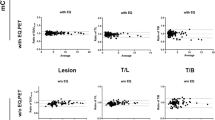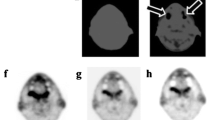Abstract
Object: This retrospective study compares the anatomical accuracy of automated rigid and non-rigid registration software for aligning data from separately performed X-ray computed tomography (CT) and positron emission tomography with F-18-deoxyglucose (PET).
Materials and methods: Analyses were performed on independently acquired PET and CT data from 40 tumor patients. Rigid as well as non-rigid automated fusion was carried out using the commercially available Mirada 7D platform (MIR and MINR, respectively) as well as a second automated non-rigid registration based on a variational image registration approach (VIR). Distances between lesion representation on PET and CT of 105 malignant lesions were measured in X-, Y-, and Z-directions. Statistical evaluation was performed using mixed effect analysis, comparing separately MIR with MINR and VIR with MINR.
Results: The percentage of lesions misregistered by less than 15 mm varied from 70% for MIR and MINR in Z-direction to 93% for VIR in X-direction. The average X-, Y- and Z-distances ranged between 5.9 ± 5.7 mm for VIR in X-direction and 12.8±9.7 mm for MIR in Z-direction. MINR was significantly more accurate than MIR in Y-direction. Furthermore, VIR aligned thoracic lesions in the X- direction significantly better than MINR.
Conclusion: The accuracy of rigid and non-rigid automated image registration can be expected to be better than 15 mm for the majority of lesions. Alignment tended to be more accurate with non-rigid registration.
Similar content being viewed by others
References
Reinartz P, Wieres F-J, Schneider W, Schur A and Buell U (2004). Side-by-side reading of PET and CT scans in oncology: which patients might profit from integrated PET/CT. Eur J Nucl Med Mol Imaging 31: 1456–1461
Hutton BF, Braun M, Thurfjell L and Lau DYH (2002). Image registration: an essential tool for nuclear medicine. Eur J Nucl Med 29: 559–577
Lardinois D, Weder W and Hany TF et al (2003). Staging of non- small-cell lung cancer with integrated positron-emission tomography and computed tomography. N Engl J Med 348: 2500–2507
Townsend DW, Beyer T and Blodgett TM (2003). PET/CT scanners: a hardware approach to image fusion. Sem Nucl Med 33: 193–204
Beyer T, Townsend DW and Brun T et al (2000). A combined PET/CT scanner for clinical oncology. J Nucl Med 41: 1369–1379
Hany TF, Steinert HC, Goerres GW, Buck A and von Schulthess GK (2002). PET diagnostic accuracy: improvement with in-line PET-CT system: initial results. Radiology 225: 575–581
Kim JH, Czernin J and Allen-Auerbach MS et al (2005). Comparison between 18F-FDG PET, in-line PET/CT, and software fusion for restaging of recurrent colorectal cancer. J Nucl Med 46: 587–595
Allen-Auerbach M, Quon A and Weber WA et al (2004). Comparison between 2-deoxy-2–18ffluoro-D-glucose positron emission tomography/computed tomography hardware fusion for staging of patients with lymphoma. Mol Imaging Biol 6: 411–416
Schaffler GJ, Groell R and Schoellnast H et al (2000). Digital image fusion of CT and PET data sets-clinical value in abdominal/pelvic malignancies. J Comput Assist Tomogr 24: 644–647
Tsai CC, Tsai CS and Ng KK et al (2003). The impact of image fusion in resolving discrepant findings between FDG-PET and MRI/CT in patients with gynaecological cancers. Eur J Nucl Med Mol Imaging 30: 1674–1683
Lemke AJ, Niehues SM and Hosten N et al (2004). Retrospective digital fusion of multidetector CT and 18F-FDG PET: clinical value in pancreatic lesions–a prospective study with 104 patients. J Nucl Med 45: 1279–1286
D’amico TA, Wong TZ, Harpole DH, Brown SD and Coleman RE (2002). Impact of computed tomography-positron emission tomography fusion in staging patients with thoracic malignancies. Ann Thorac Surg 74: 160–163
Rizzo G, Castiglioni I and Arienti R et al (2005). Automatic registration of PET and CT studies for clinical use in thoracic and abdominal conformal radiotherapy. QJ Nucl Med Mol Imaging 49: 267–279
Halpern BS, Schiepers C and Weber WA et al (2005). Presurgical staging of non-small cell lung cancer: positron emission tomography, integrated positron emission tomography/CT, and software image fusion. Chest 128: 2289–2297
Römer W, Nömayr A and Greess H et al (2006). Retrospective interactive rigid fusion of F-18 FDG-PET and CT: additional diagnostic information in melanoma patients. Nuklearmedizin 45: 88–95
Lavely WC, Scarfone C and Cevikalp H et al (2004). Phantom validation of coregistration of PET and CT for image-guided radiotherapy. Med Phys 31: 1083–1092
Kraus GE, Bernstein TW, Satter M, Ezzeddine B, Hwang DR and Mantil J (1995). A technique utilizing positron emission tomography and magnetic resonance/computed tomography image fusion to aid in surgical navigation and tumor volume determination. J Image Guid Surg 1: 300–307
Sureshbabu W and Mawlawi O (2005). PET/CT imaging artifacts. J Nucl Med Technol 33: 156–161
Cohade C, Osman M, Marshall LN and Wahl RN (2003). PET-CT: accuracy of PET and CT spatial registration of lung lesions. Eur J Nucl Med Mol Imaging 30: 721–726
Goerres GW, Kamel E, Heidelberg TNH, Schwitter MR, Burger C and von Schulthess GK (2002). PET-CT image co-registration in the thorax: influence of respiration. Eur J Nucl Med Mol Imaging 29: 351–360
Nömayr A, Römer W and Hothorn T et al (2005). Anatomical accuracy of lesion localization: retrospective interactive rigid image registration between 18F-FDG-PET and X-ray CT. Nuklearmedizin 44: 49–55
Herzog H, Tellmann L, Hocke C, Pietrzyk U, Casey ME and Kuwert T (2004). NEMA NU2–2001 guided performance evaluation of four Siemens ECAT PET-Scanners. IEEE Trans Nucl Sci 51: 2662–2669
Hermosillo G, Chefd’Hotel C and Faugeras O (2002). Variational methods for multi-modal image matching. Int J Comput Vision 50: 329–343
Hahn DA, Hornegger J, Bautz W, Kuwert T and Römer W (2005). Unbiased rigid registration using transfer functions. Proc SPIE 5747: 151–162
Wolz G, Nömayr A and Hothorn T et al (2007). Anatomical accuracy of interactive and automated rigid registration between X-ray CT and FDG-PET. Nuklearmedizin 46: 43–48
Pinheiro JC and Bates M (2000). Mixed-effects models in S and S-PLUS. Springer, New York
R Development Core Team (2006) R: A language and environment for statistical computing. R Foundation for statistical Computing, Vienna, Austria. http://www.R-project.org
Bates M, Sakar D (2006) lme4: Linear mixed-effects models using S4 classes. R package version 0.995–2. http://CRAN.R-project.org
Inagaki H, Kato T and Tadokoro M et al (1999). Interactive fusion of three-dimensional images of upper abdominal CT and FDG PET with no body surface markers. Radiat Med 17: 155–163
Nakamoto Y, Sakamoto S and Okada T et al (2005). Accuracy of image fusion using a fixation device for whole-body cancer imaging. AJR Am J Roentgenol 184: 1960–1966
Skalski J, Wahl RL and Meyer CR (2002). Comparison of mutual information-based warping accuracy for fusing body CT and PET by 2 methods: CT mapped onto PET emission scan versus CT mapped onto PET transmission scan. J Nucl Med 43: 1184–1187
Meyer CR, Boes JL and Kim B et al (1997). Demonstration of accuracy and clinical versatility of mutual information for automatic multimodality image fusion using affine and thin-plate spline warped geometric deformations. Med Image Analysis 1: 195–206
Shekhar R, Walimbe V and Raja S et al (2005). Automated 3-dimensional elastic registration of whole-body PET and CT from separate or combined scanners. J Nucl Med 46: 1488–1496
Mattes D, Haynor DR, Vesselle H, Lewellen TK and Eubank W (2003). PET- CT image registration in the chest using free-form deformations. IEEE Trans Med Imaging 22: 120–128
Slomka PJ, Dey D, Przetak C, Aladl UE and Baum RP (2003). Automated 3-dimensonal registration of stand-alone 18F-FDG whole-body PET with CT. J Nucl Med 44: 1156–1167
Krishnasetty V, Fischman AJ, Halpern EL and Aquino SL (2005). Comparison of alignment of computer-registered data sets: combined PET/CT versus independent PET and CT of the thorax. Radiology 237: 635–639
Goerres GW, Burger C, Schwitter MR, Heidelberg TN, Seifert B and von Schulthess GK (2003). PET/CT of the abdomen: optimizing the patient breathing pattern. Eur Radiol 13: 734–739
West J, Fitzpatrick JM and Wang MY et al (1997). Comparison and evaluation of retrospective intermodality brain image registration techniques. J Comput Assist Tomogr 21: 554–566
Gütter C, Xu C, Sauer F et al (2005) Non-rigid multi-modal image registration using Kullback–Leibler divergence MICCAI ’05: Proceedings of the 8th International Conference on Medical Image Computing and Computer Assisted Intervention—Part II, vol 3750. Springer, Heidelberg, pp 255–262
Jäger F, Han J, Hornegger J and Kuwert T (2006). A variational approach to spatially dependent non-rigid registration. Proc SPIE 6144: 860–869
Author information
Authors and Affiliations
Corresponding author
Additional information
This work was supported by the ELAN-Fonds of the Clinical Faculty of the University of Erlangen-Nürnberg (AZ: 04.03.10.1) as well as by the Deutsche Forschungsgemeinschaft (DFG), Sonderforschungsbereich 603, Teilprojekt C10.
Rights and permissions
About this article
Cite this article
Wolz, G., Nömayr, A., Hothorn, T. et al. Comparison of performance between rigid and non-rigid software registering CT to FDG-PET. Int J CARS 2, 183–190 (2007). https://doi.org/10.1007/s11548-007-0128-y
Received:
Accepted:
Published:
Issue Date:
DOI: https://doi.org/10.1007/s11548-007-0128-y




